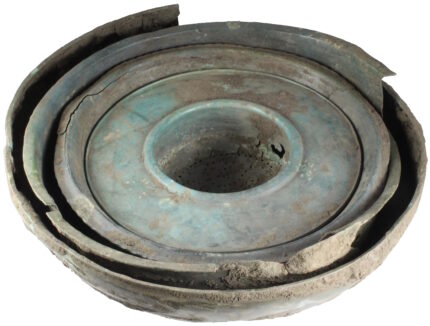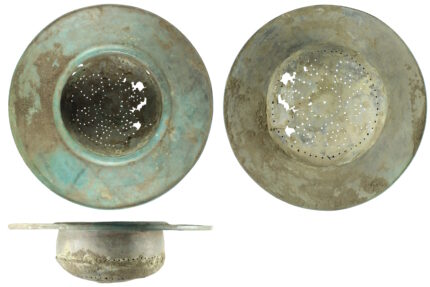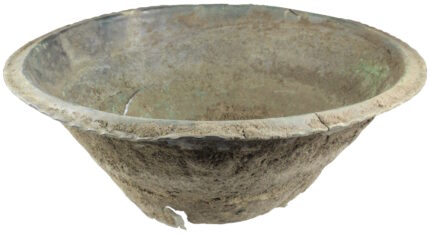 The Wiltshire Museum has acquired a nationally significant hoard of Roman bronze vessels. The four copper-alloy vessels were discovered nested inside of each other at Wilcot in 2017. The vessels are fragmented with the bases of three of the four broken, so they are in urgent need of professional care.
The Wiltshire Museum has acquired a nationally significant hoard of Roman bronze vessels. The four copper-alloy vessels were discovered nested inside of each other at Wilcot in 2017. The vessels are fragmented with the bases of three of the four broken, so they are in urgent need of professional care.
They are so fragile they can only be removed from their packing by experienced conservators and are now being conserved for display in the Museum, thanks to the support of over 40 people who donated to our appeal in April 2023. […]
Lisa Brown, Curator at Wiltshire Museum, has found that the bronze vessels are fragile, and urgently needed conservation and cleaning to remove dried on soil and to prepare them for display. Conservation experts, Drakon Heritage and Conservation, have been selected to undertake this incredibly delicate task, after which they will be displayed in the Museum, showing how they were deposited in the ground 1,600 years ago.
 The hoard consists of a symmetrical flanged bowl strainer, a basin with an out-turned flanged rim known as a Bassin Uni, a carinated basin with a foot ring and an Irchester bowl. The strainer was placed inside the Bassin Uni which was then placed inside the carinated basin. The three nested vessels were finally placed inside the Irchester bowl. There is evidence that heather, grasses or other soft plant materials were used to pad the vessels and protect them like ancient bubblewrap.
The hoard consists of a symmetrical flanged bowl strainer, a basin with an out-turned flanged rim known as a Bassin Uni, a carinated basin with a foot ring and an Irchester bowl. The strainer was placed inside the Bassin Uni which was then placed inside the carinated basin. The three nested vessels were finally placed inside the Irchester bowl. There is evidence that heather, grasses or other soft plant materials were used to pad the vessels and protect them like ancient bubblewrap.
The strainer is circular with a broad flanged rim. It has a hemispherical perforated strainer in the center. This was originally a single piece of copper allow shaped into a strainer bowl, but it was damaged at some point and a curved copper-allow sheet was riveted to the body of the vessel to repair it.
The Bassin Uni is incomplete, but it was well-crafted with a crimped rim and an omphalos (navel-like) base. It bears the original hammer marks. The sides are adorned with bands of repousse decoration. The base has become detached over the centuries.
The carinated basin has a wide rim and tapers towards the piece. It was constructed from two pieces of copper-alloy. A perforation in the omphalos base indicates it was produced on a lathe. At the base is a foot ring.
 The Irchester bowl has a convex base that widens just below the rim. The rim has a thick bevelled edge. This type of vessel was produced in the 4th and 5th century, which gives us the outside date for the deposition of the hoard.
The Irchester bowl has a convex base that widens just below the rim. The rim has a thick bevelled edge. This type of vessel was produced in the 4th and 5th century, which gives us the outside date for the deposition of the hoard.
The carinated basin is believed to date to the first half of the 2nd century, while the strainer was made in Britain during the 1st century. From repairs visible on the strainer, archaeologists have concluded it was used for a long time before it was finally deposited. Both the basin and the strainer, therefore, were already antiques when they were buried.